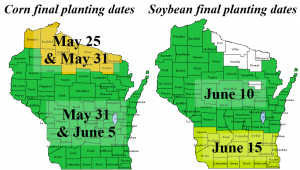Paul D. Mitchell, Agricultural and Applied Economics, UW-Madison
Office: (608) 265-6514 Email: pdmitchell@wisc.edu Web: http://www.aae.wisc.edu/mitchell/extension.htm
Want a printable version? Click HERE
As many Wisconsin farmers are taking prevented plant payments for their insured corn or soybeans acres, they are asking what they can use for cover crops on these acres. Traditional cover crop seed is hard to find this year with all the prevented plant acres in the region and farmers already have corn and/or soybean seed. Thus the question: Can I use corn or soybeans as a cover crop on prevented plant acres? The short answer is yes, but only if planted sufficiently late and if the cover crop is never harvested for grain or seed. Note that after September 1, a cover crop can be grazed, baled for hay or baled for straw/stover for bedding, or harvested for silage, haylage or baleage, including a corn or soybean corn crop. This bulletin provides guidance to farmers, examining at three options. For agronomic information on corn and soybeans as cover crops, see https://coolbean.info/2019/06/13/soybean-corn-considered- cover-crop-options-wi/.

First, if a farmer takes the full prevented plant indemnity, planting the same crop as a cover crop before the end of the late planting period is not allowed. Instead, the farmer should report it as late planted with a reduced guarantee. For all but northern Wisconsin, June 25 is the end of the late planting period for corn grain, June 30 for corn silage. For soybeans, the late planting period
ends on July 5 for the northern two-thirds of Wisconsin and on July 10 for the southern third. Therefore, after taking a full prevented plant indemnity, planting corn or soybeans as a cover crop before these dates is not allowed.
These maps shows the dates for the end of the late planting periods for each Wisconsin county. If a farmer wants to plant a cover crop during this period, something other than corn and soybeans should be planted.
Second, if the goal is to harvest forage from prevented plant acres, then farmers should take the partial prevented plant payment (35% of the full payment) and acknowledge forage as the alternative crop. Corn silage can be an alternative crop for corn for grain, if the farmer can show that corn for grain was the original intent. On June 20, the RMA announced new rules pertaining to forage production on prevented plant acres that offer better forage production options.
Previously, farmers had to wait until after November 1 and could only graze the cover crop or bale it as hay for feed or as straw/stover for bedding. Now, for 2019 only, they only have to wait until after September 1 and can also chop the cover crop for silage, haylage or balage. These dates and practices are less risky for forage production in Wisconsin and some farmers may want to take advantage of this new option. These rules only pertain to making forage from a cover crop planted after receiving the full prevented plant indemnity, not forage as an alternative crop planted after receiving a partial prevented plant indemnity. If farmers have questions, they should consult with local agronomic experts for recommended crops for forage production as an alternative crop. Potentially, a full season corn hybrid (105-110 days) planted in early July may be a viable option for corn silage production as an alternative crop, but it will not be insurable.
Third, for farmers taking the full prevented pant indemnity and wanting to plant a cover crop, the RMA does not have an official list of approved cover crops. RMA states that “For crop insurance purposes, a cover crop is a crop generally recognized by agricultural experts as agronomically sound for the area for erosion control or other purposes related to conservation or soil improvement.” (https://www.rma.usda.gov/en/Fact-Sheets/National-Fact-Sheets/Cover- Crops-and-Crop-Insurance). In Wisconsin, the state corn and soybean agronomists have provided a publically available written guidance on how to use corn or soybeans as a cover crop on prevented plant acres in Wisconsin including recommended agronomic practices (https://coolbean.info/2019/06/13/soybean-corn-considered-cover-crop-options-wi/). Also, corn and soybeans used as a cover crop should be managed as a cover crop (e.g., less than full rate fertilization, no application of fungicides during summer). If farmers use corn or soybeans as a cover crop, they should carefully document their practices as management for a cover crop (not a forage crop), including the destruction of the corn or soybean cover crop (e.g., with dated photographs). The purpose is to show that it was managed as a cover crop, that it was not harvested for grain or seed, and if they grazed it, chopped it for silage, or baled it for hay, straw/stover, or baleage, that they did not do so until after September 1, and that was it clearly for hay, bedding or silage.
Finally, many farmers have been wondering about the impact of prevented plant acres on USDA support payments. The market facilitation program (MFP) has been announced for 2019, with Secretary Perdue making an official press release on June 10: https://www.usda.gov/media/press- releases/2019/06/10/secretary-perdue-statement-disaster-and-trade-related-assistance. At this time, it seems that MFP payments will not be made for prevented plant acres (see item 4), but these interpretations can evolve, as MFP is authorized by executive order, not an existing law.
Prevented plant payments do not affect Agricultural Risk Coverage (ARC) or Price Loss Coverage (PLC) payments. Lastly, how the USDA Farm Service Agency will count prevented plant acres as acres planted for determining base acres is officially unclear and has to be clarified by Congress.
